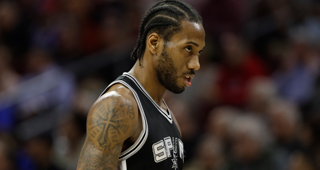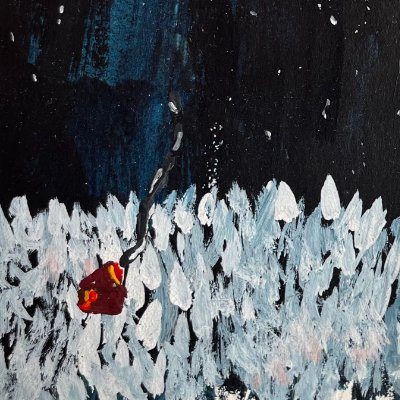For nearly twenty years, the San Antonio Spurs have measured the rest of the league. When they won their first title in 1999, the NBA was finding a new balance after Michael Jordan’s retirement and bleary-eyed from a lockout hangover. When they won again in 2003, it was a sign that Shaq and Kobe’s Lakers were slipping after three seasons of sky-darkening dominance. They were the hurdle the Seven Seconds or Less Suns couldn’t ever quite get over in the mid-aughts. They swatted down a young LeBron plus a bunch of Cavaliers scrubs in the 2007 Finals. When the Durant-Westbrook-Harden Thunder beat them in the 2012 Western Conference Finals, it felt like a changing of the guard. Then the Thunder shipped Harden out and San Antonio split a pair of championship bouts with LeBron’s Heat, the 2014 team factoring heavily into James’s return to Cleveland by running an aging Miami squad off the floor in the Finals.
It’s a mite surprising, then, that the Spurs and Steve Kerr’s Warriors hadn’t met in the playoffs until now, but it’s fitting that Pop’s boys suffered a walloping. The Spurs, as ever, are an excellently coached team with a bunch of improbably effective role players, some wily vets, and one of the league’s best players, but the Warriors are world-historically talented, like if the ‘86 Celtics had employed a still-in-his-prime Bill Walton instead of the banged up model who came off the bench, or if Shaq and Kobe’s Lakers also had Vince Carter on the wing or Jason Kidd playing point guard. The Spurs have never been like that. Over the years, they have usually beaten flawed teams and lost when they’ve been severely outmanned. These Kevin Durant-reinforced Warriors: they beat everybody. It remains to be seen if even LeBron’s Cavs—far and away the second-best team in the league—can hang with them in these upcoming Finals. The Dubs were always going to easily oust the Spurs, though it’s a shame they had to do so without Kawhi Leonard having much of a say in the matter.
Maybe it’s the Warriors’ gobsmacking brilliance, or Tony Parker and Manu Ginobili looking just about cooked, or LaMarcus Aldridge’s impassiveness, or the fact that Popovich is nearly seventy, but the Spurs seem to be on the verge of either a mild decline or an upheaval. Of course, two decades of history doesn’t suggest as much. This current Spurs team is the fourth or fifth distinct iteration of the Popovich era. Every time it looks like the franchise is slipping, the squad turns over a little bit and Pop tweaks the offense. They’re the league’s greatest incrementalists, and have, at various points, played fast and slow, been Duncan-centric, and Parker-centric, and fluid and without a focal point. These days, they play through Kawhi in a slightly more iso-heavy style than Popovich has ever previously allowed. That the Spurs have had a consistent identity through all of this challenges our ideas about what composes a franchise’s identity, because the only throughline has been a few familiar faces—soon, finally, departing—and extreme competence. Spursiness, if that’s a thing, stands in for smarts and optimization more than any one ethos or style.
If they do want to make a drastic change, the Spurs have limited flexibility this summer. Parker and Pau Gasol each have one more pricey year left on their contracts ($15.5 million and $16.2 million, respectively). There’s buzz about Aldridge getting sent elsewhere, but no obvious destination. He’s an undeniably skilled player, but his rebound numbers are declining; he prefers eighteen-footers to three-pointers; and he doesn’t protect the rim. Plus he’s thirty-one. He’ll be difficult to move and harder still to get decent value for. Even if Aldridge were simply salary-dumped in order to create cap space, this year’s free agents stars not named Gordon Hayward—Chris Paul, Kyle Lowry, Paul Millsap if you’re being loose with your terminology—are all over thirty and quickly coming up on the end of their primes. Kawhi Leonard is twenty-five and signed through 2019 (with a player option to stay through 2020). He wouldn’t be happy, nor would the Spurs, if as he hits his absolute peak in his late twenties, his expensive help is washed up.
And the Warriors render all but the most transformative maneuvering moot. This doesn’t mean the rest of the league shouldn’t try to improve or put themselves in position to succeed down the line—it’s nice to win games, if not titles—but there’s no point in any franchise threatening its own long-term health with any kind of win-now gambit because unless they’re constructing a super-team, it’s not going to work.
Yet the Spurs don’t stagnate. They have down years—which is to say they go for fifty-plus wins and a first-round playoff exit—but they are constantly retooling, only ever briefly settling into a rut. Especially in this moment, they can’t afford to. It’s not out of the question that the Warriors will continue to be awesome all the way through 2019, when Kawhi is likely to turn down his player option and decide whether he wants to spend his best years with the Spurs or join up somewhere else. Popovich and R.C. Buford have to give some compelling reasons to stick around.
It will be an exceedingly tricky balance to strike—keeping Kawhi’s faith and remaining competitive while also not doing anything too rash that might sink the possibility of a Kawhi-centric contender in 2021. Players don’t tend to think long-term, and they don’t like to be told what’s possible and what’s not, and that’s doubly true for the league’s ultra-competitive superstars. Perhaps Kawhi is different, or perhaps the Spurs have the persuasive power to make their players see what others don’t. Regardless, there’s difficult work to be done. The Spurs have the collective capability to take it on, but that doesn’t make the task any less daunting.



